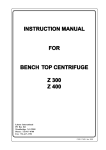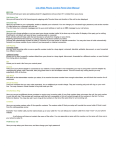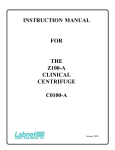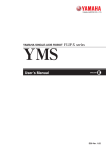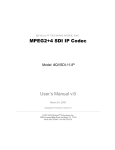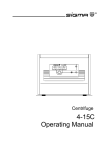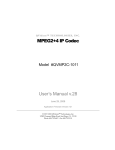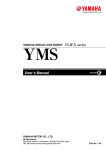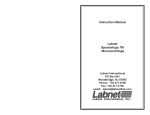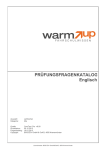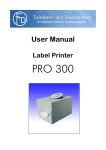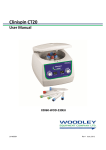Download Z233M - Phenix Research Products
Transcript
INSTR UCTION MANU AL INSTRUCTION MANUA FOR OCENTRIFUGE MICR MICROCENTRIFUGE Z 233 M-2 National Labnet Company PO Box 841 Woodbridge, NJ 07095 Phone: (732) 417-0700 Fax: (732) 417-1750 1 INDEX 1. 2. 3. 4. General Information 1.1 Precaution and hazards................................................................................. 3 1.2 Description ..................................................................................................... 4 1.3 Do not operate the centrifuge under the following conditions ....................... 4 1.4 Safety standards ........................................................................................... 4 1.5 Technical data ............................................................................................... 5 1.6 Accessories supplied with each centrifuge unit ............................................. 6 1.7 Warranty ........................................................................................................ 6 Installation 2.1 Unpacking the centrifuge ............................................................................... 6 2.2 Required space ............................................................................................. 6 2.3 Installation ..................................................................................................... 7 How to install and load a rotor 3.1 Mounting and securing an angle rotor ........................................................... 7 3.2 Set or change rotor-code ............................................................................... 8 3.3 Overloading rotors ......................................................................................... 9 3.4 Removing the rotor ........................................................................................ 9 Operation 4.1 Power ............................................................................................................ 10 4.2 Lid release ..................................................................................................... 10 4.3 Lid lock .......................................................................................................... 10 4.4 Preselection of speed / RCF ......................................................................... 11 4.5 Preselection of operating time ....................................................................... 11 4.6 Preselection of brake intensity and acceleration ........................................... 12 4.7 Keyboard - Starting the centrifuge - "quick"-key ............................................ 13 4.8 "Stop" key ....................................................................................................... 13 5. Temperture 13 6. 5.1 Temperture ....................................................................................................... Safety facilities 6.1 14 6. 7. 2 Page Imbalance ...................................................................................................... Service and Maintenance 6.1 Service and inspection of centrifuge ............................................................. 15 6.2 Cleaning the centrifuge.................................................................................. 15 6.3 Cleaning of centrifuge after breakage of glass tubes/bottles ........................ 16 6.4 Disinfection .................................................................................................... 16 Breakdown 7.1 Emergency lid release ................................................................................... 15 7.2 Check list / Trouble shooting ......................................................................... 16 1. General Information 1.1 Precautions and hazards Before putting the centrifuge into operation, please read this instruction manual carefully. The centrifuge must not be operated by unqualified persons not familar with the correct use and intended purpose of the machine. Please use only the original spare parts. For personal and environmental safety, pay special attention to the precautions: following The Hermle Z 233 M-2 is neither explosion proof nor inert gas shielded and should, therefore, never be operated in explosive-hazardous locations. Never stay in the safety zone of 30 cm around the centrifuge or deposit dangerous materials inside this zone during centrifugation. The centrifugation of flammable, explosive or radioactive samples is not allowed. Do not spin samples which can chemically react with each other when exposed to air. Never spin toxical or pathological material without adequate safety precautions i.e. centrifuging of buckets/tubes without or with defective hermetic sealing is not allowed. The end-user should perform appropriate disinfection procedures in the event of dangerous materials contaminating the centrifuge or its accessories. General universal laboratory precautions should be observed if infectious materials are centrifuged. If necessary, please contact a health safety officer! It is prohibited to run the centrifuge with rotors not suited for this centrifuge model. Under no circumstances, should the centrifuge lid be opened while the rotor is still turning (running with a speed of more than 2 meters per second). The following rules must be strictly adhered to: by Do not operate the centrifuge if it is not installed correctly. Never operate the centrifuge in a disassembled state ( e.g. without sheet metal cover). Do not run the centrifuge if electrical or mechanical systems have been tampered with unauthorized persons. Never use accessories such as rotors and buckets which are not exclusively approved by Hermle Labortechnik GmbH or National Labnet Company Company, except commercially available centrifuge tubes of glass or plastic. Do not spin corrosive samples which may cause damage to the centrifuge and impair the mechanic resistance. Never operate the centrifuge with rotors or buckets which show any signs of corrosion or mechanical damage The manufacturer is only responsible for the security and reliability of the centrifuge if: The unit is operated according to the instruction manual. Modifications, repairs and new adjustments are performed by HERMLE or Labnet authorized persons and the electrical installation of the location where the centrifuge is operated corresponds to the IEC-regulations. 3 2 1.2 Description Model Z 233 M-2 is a microcentrifuge. Four rotors for microcentrifuge tubes are available (24 x 1.5ml, 44 x 1.5ml, 48 combo 24x1.5, 24 x 0.5ml, and 64 x .05ml). The Z 233 M-2 is microprocessor controlled and has a maintenance-free induction drive motor. 1.3 Do not operate the centrifuge if: - The unit is not installed correctly. - The unit is partly dismantled. - The unit was serviced by non-authorized or non-qualified personnel. - The rotor is not installed securely on the motor shaft. - Rotors or accessories will be used which are not authorized for this unit by Hermle or Labnet. Exception: Commercially available tubes or bottles made of glass or plastic. - The unit is in explosive atmospheres. - Combustible or explosive samples are used. - Samples are used which can mix and react chemically with each other. 1.4 Safety standards The centrifuge corresponds to the general requirements set by German law for medical apparatus, "MedGV" group 3. The following standards have been considered for the production of our centrifuges: - Accident prevention rules for centrifuges, UVV-VBG 7z. - Accident prevention rules for electrical equipment & installations, UVV-VBG 4. - International Standard IEC 1010-1 and IEC 1010-2-D - European Standard PR EN 61010-1 and PR EN 61010-2-2 - Electrical interference suppression according to interference degree B as per VDE 0871. 4 1.5 Technical Data ______________________________________________________________________ Manufacturer Hermle Labortechnik GmbH ______________________________________________________________________ Type Z 233 M2 ______________________________________________________________________ Dimensions: Width 28 cm Depth 37 cm Height 26 cm ______________________________________________________________________ Weight 17 kg ______________________________________________________________________ Noise level 64 dB(A) ______________________________________________________________________ Max. speed Max. volume Max. RCF Admiss. density 14 000 rpm 44 x 2.0ml 18,620 x g 1.2 kg/dm3 Admiss. kinetic energy 3761 Nm ______________________________________________________________________ Electrical connection AC Current Connected load 230 V/50 Hz 6A 460 Watt 120 V/60 Hz 6.5 A 610 Watt ______________________________________________________________________ Interference suppression VDE 0871, interference degree B ______________________________________________________________________ Service dept. at Labnet (732) 417-0700 ______________________________________________________________________ Address of service: National Labnet Company 162 Fernwood Avenue Edison, NJ 08837 5 1.6 Accessories supplied with each centrifuge unit 2 Fine-wire fuses 6.3 AT, 1 Instruction manual, 1 Tool for removing the rotor 1.7 Warranty This centrifuge has been subjected to thorough testing and quality control during the production process. In the unlikely event of any manufacturing faults occuring, the centrifuge and rotors are covered by warranty for a period of one year from date of delivery. This warranty becomes invalid in case of improper operation, use of nonappropriate spare parts or accessories and non-authorized modification of rotor or centrifuge. The manufacturer reserves the right to make technical modifications to the product for the purpose of technical improvement. 2. Installation 2.1 Unpacking the centrifuge The Z 233 M-2 is supplied in a carton with corrugated cardboard inserts. Open the carton and remove the corrugated cardboard inserts, then gently remove centrifuge from carton. The instruction manual and the accessories mentioned under 1.6 should be kept with the centrifuge. Please keep all packaging in safe storage for at least 1 year for warranty purposes. 2.2 Required space The centrifuge should be installed on a rigid, even surface. The centrifuge should only be operated on a stable laboratory table/cabinet etc. Balance the centrifuge with a spirit level. To guarantee the necessary heat dissipation, the unit must be situated so that there is a space of at least 15 cm on each side of the unit. Never place the centrifuge in an area subject to excessive heat, e.g., strong sunlight, as the performance of the unit is based upon an ambient temperature of +23°C. Attention: New safety standards require a safety margin space of 30 cm around the centrifuge. Mark this area to indicate that personnel and dangerous material (e.g. flammable or infectious liquids) should be kept outside this area during operation. 6 2.3 ! 3. Installation Check that: - the power supply corresponds to that on the manufacturer's rating label which is mounted on the rear panel, then connect the power cord to the centrifuge and the socket. - The line voltage circuit breaker has a maximum of 16 Amp. type K slow release for commonly used instruments. - An emergency switch is installed outside the room to disconnect the power supply in case of a troubled run. - The digital indications on the display are lighting up. - Press the "lid" key. You can open the centrifuge lid now. How to install and load a rotor 3.1 Mounting and securing an angle rotor Clean the motor shaft, as well as the rotor mounting hole with a piece of cloth and place the rotor on the motor shaft ensuring that the pins align correctly with the rotor slots. Figure 1a Figure 1b Hold the rotor with one hand and secure the rotor to the shaft by turning the rotor nut (1) counter-clockwise (see figure 2). 1 Figure 2 ATTENTION ! If using a rotor that was not originally supplied with the centrifuge, you have to change the standard rotor-code which is programmed (see chapter 3.2, page 7 E). 7 -Load the rotor symmetrically by inserting tubes into spaces opposite from each other. The rotor must always be balanced in this fashion prior to operation. ATTENTION: Before operation, secure the rotor lid to the rotor by pressing the snap connector lightly on the rotor nut (see figure 3). Figure 3 3.2 Set or change rotor-code . With a new unit, the centrifuge is programmed with the rotor-code for the rotor that has been ordered with the machine. If you wish to use another rotor you have to change the rotor code. Please proceed as follows: Open centrifuge lid and unplug the centrifuge. Press the"lid" key (2), (see figure 4), hold it and at the same time plug in the centrifuge. Z233M-2 1 2 Note: To check rotor code turn power on (plug in), open lid and press the "Quick" button. Rotor code is now displayed. Figure 4 8 On the digital display for "speed rpm / rcf g x 10" the number code for the set rotor type appears. On the digital display "time min-sec" the letters "ro" ( rotor ) appears. Turn the speed knob (1), (see figure 4) till the required rotor code appears on the display. Rotor Rotor code C0230-2A, 24 x 1.5ml 59 C0200-95, 18 x 1.5ml C0230-9A, 44 x 1.5ml 88 C0230-43A, 64 x .05ml 92 95 C0230-55A, 24 x 1.5, 24 x 0.5ml 88 C0230-TSA Strip tube 4 x 8 - 0.2ml 59 After doing that, disconnect the power supply and put it back and the new rotor number is stored. 3.3 Overloading rotors The max. load permitted for a rotor, which is determined by the manufacturer, as well as the max. speed allowed with the rotor (see indications on the rotor itself) must not be exceeded. The liquids with which the rotors are loaded should have an average homogeneous density of 1.2g per ml or less, when the rotor is running at maximum speed. To spin liquids of a higher density, the speed has to be reduced according to the following formula: Reduced speed n red = Example: n red = 1,2 higher density value 1,2 x max. speed (n ) max x 4000 = 3360 rpm 1,7 In case you have any questions, please contact the National Labnet! 3.4 Removing the rotor Take off the rotor lid and hold the rotor with one hand. Turn the rotor nut clockwise, until the rotor is loose and take the rotor vertically off the shaft. ATTENTION: Never operate the centrifuge with rotors or buckets which show any signs of corrosion or mechanical damage. Never operate with strongly corrosive materials which could damage rotor and buckets. 9 4. Operation 4.1 Power You can switch on the centrifuge by plugging in the power supply. The digital indications on the display will light up when the power is on. 4.2 Lid release When the green control lamp of the "lid" key (1) lights, the rotor is not moving and the centrifuge lid is ready to open. Press the "lid" key (1) (see figure 5) to open the lid. The green control lamp(2) will extinguish as soon as the lid is opened or the unit started. Z233M-2 2 1 Figure 5 4.3 Lid lock Close the centrifuge lid, after the rotor has been fixed correctly as described. The centrifuge can only be started when the lid is closed correctly. The green control lamp of the "lid" key will light as soon as the lid is closed correctly. When the rotor starts accelerating the control lamp of the "lid" key extinguishes and the lid cannot be opened. 10 4.4 Preselection of speed / RCF When the centrifuge lid is open, you can preset the required speed or rcf with the speed knob (1). With the "speed/rcf" key (2) you can change the display from speed to g-value. The green control lamps (3) show which mode is activated. If the centrifuge lid is closed and during the run, the speed can be changed as follows: Press the "preset" key (4), hold it and at the same time change speed or g-value with the speed knob. The max. speed for all rotors is 14 000 rpm. Z233M-2 4 1 2 3 Figure 6 11 4.5 Preselection of operating time You can adjust the desired operating time between 1 and 60 minutes or hold. With the centrifuge lid open you can preset the operating time with the knob (3). During a run and with the centrifuge lid closed you have to press the "preset" key (1), hold it and change operating time by turning the knob (3). The preselected running time will be indicated on the time display (2). At the end of a run the preset operating time will be kept for further runs. 1 2 3 4 Figure 7 For continuous runs turn the knob clockwise to the limit stop. The continuous run will be indicated on the digital display with two minus signs "--". You can check the operating time during a continuous run as follows: - min/sec. Press the start botton (4). After this, the operating time will be automatically displayed in the following sequence: For example 4 hours and 13 minutes operating time: min/sec. continuous run press start symbol "h" for hours min/sec. number of hours min/sec. symbol "m" for minutes min/sec. min/sec. number of minutes running time indication end continuous run Attention: to check the operating time you have to wait one minute after start You can stop a continuous run with the "stop" key. 12 4.6 Preselection of brake intensity and acceleration With the "fast/slow" key (1) you have the choice between two steps of brake and acceleration intensity. 1 Figure 8 If the green "fast" control lamp is lit, the unit accelerates and decelerates fast. If the green "slow"control lamp is lit, the unit accelerates and decelerates very softly below 2 000 rpm. slow fast preset speed 2000 rpm Acceleration times fast / slow in seconds: Rotor C0200-95 Rotor C0230-43A 18 x 1.5ml 64 x .05ml (10 / 29) (15 / 25) 9 / 20 17 / 25 Rotor C0230-2A 24 x 1.5ml (10 / 20) 15 / 26 Rotor C0230-9A and C0230-55A 44 x 1.5ml and 24 x 1.5, 24 x.05ml (15 / 25) 17 / 25 Deceleration times fast / slow in seconds: Rotor C0200-95 Rotor C0230-43A 18 x 1.5ml 64 x .05ml (9 / 13) (16 / 27) 11 / 18 19 / 34 Rotor C0230-2A 24 x 1.5ml (13 / 23) 15 / 28 Rotor C0230-9A and C0230-55A 44 x 1.5ml and 24 x 1.5, 24 x.05ml (16 / 27) 19 / 34 The numbers in brackets for 220V/50-60Hz Non brackets numbers for 120V/50-60Hz 13 4.7 Keyboard - Starting the centrifuge - "quick"-key 1 "Lid" key: To open the centrifuge lid. If the green LED of the "lid" key is lit, the lid is closed correctly. 2 "Quick" key: For short time runs. 3 "Start" key: To start the centrifuge. 4 "Stop" key: To stop the centrifuge befor the preset operating time has expired or to stop the centrifuge during a continuous run. Figure 9 Starting the centrifuge The rotor has to be fixed correctly and completely loaded. Close the centrifuge lid. As soon as the green LED of the "lid" key is lit the centrifuge can be started. Then press the "start" key. "quick" - key - Short time runs For short centrifuge runs you can start the run with the "quick" key. Press the "quick" key. The centrifuge starts and keeps running as long as you press the "quick"-key. The operating time will be indicated in seconds on the digital "time" display. 4.8 "Stop" key Press the "stop" key if you want to interrupt a centrifuge run. The centrifuge decelerates according to the adjusted brake intensity. You can change the brake intensity during deceleration. 14 5. Temperature Features 5.1 Temperature During centrifugation, heat is generated by air friction between the rapidly spinning rotor and the air inside the rotor chamber. The temperature rise depends on the rotor ( swing-out or angle rotor ),bucket type, ambient temperature, running time and the speed of the rotor. The continous air flow through the centrifuge housing is restricting the temperature rise of the samples to the standard value of 40°C with each rotor even at maximum speed. 6. Safety facilities 6.1 Imbalance In case of unequal loading of opposite buckets/tube racks or tube-holes, the operation will be interrupted during the acceleration phase. The rotor will be decelerated to a standstill. Additionally the message "ERROR" appears on the preset "speed" display. If the actual "speed" display shows error no. 1, the difference in weight of the samples is too big. Fill the tubes and load the rotor as described under point 3. If the actual "speed" display shows error no. 2, there can be several reasons: - The imbalance switch is not adjusted correctly. - The imbalance switch is defective. 15 7.1 Service and inspection of centrifuge Centrifuge service and inspection should be done regularly and only by authorized and qualified personnel. Use only original spare parts! 7.2 Maintenance and cleaning Maintenance The maintenance of the centrifuge involves essentially keeping the rotor chamber, the rotor and the accessories clean. Please pay special attention to anodized aluminium parts. Breakage of rotors can be caused even by slight damages. In the case of rotor, buckets or tube racks contacting corrosive liquids, the respective spots and parts have to be cleaned carefully. Corrosive liquids are for example: alkaline soup-solution alkaline amino strong acids solutions containg heavy metals waterfree and chlorinated solvents salt solutions e.g. sea-water Cleaning: The purpose of a thorough cleaning is, beside hygienic reasons, the avoidance of corrosion by soiling. In order to avoid the damage of anodized parts such as rotors, reduction plates ect., only neutral cleaning agents with a ph-value 6-8 should be used. Never use an alkaline cleaning agents ( ph > 8 ). After cleaning please ensure that all parts are dried thoroughly by hand or in a warm-air-cabinet ( max. temperature +50°C ). anti risk removed 16 It is recommended that all anodized aluminum parts are regularly treated with corrosion oil, so that their durability will be increased and the corrosion reduced. Usually when used in a cold room, humidity and non hermetically closed samples, may cause condensation to form. The condensation should be regulary with a cloth from the rotor chamber. Unplug the centrifuge when it is not being used, allow the chamber to reach room temperature, and dry out the chamber with a cloth. 7.3 Cleaning of centrifuge after breakage of glass tubes/glass bottles With high g-values, there is a possibility that tube breakage will occur. Should this happen, the centrifuge, rotor, buckets, adapters and the rotor chamber must be thoroughly cleaned and all broken particles removed immediately. If this is not done, they could scratch the protective coating of the rotor. If the rotor chamber has not been properly cleaned, this will produce a fine black dust which can cause significant damage to the centrifuge chamber, rotor, buckets and the samples. 7.4 Disinfection If, for example through tube breakage, infectious material is spilled into the centrifuge, the rotor and the rotor chamber should be disinfected !!! Rotor is autoclavable. Rotor and rotor chamber should then be treated with a neutral disinfection agent, for example: 10% bleach solution. A disinfectant spray should be used to thoroughly clean the chamber, rotor, adapters etc.. 8. Breakdown 8.1 Emergency lid release In case of power failure or any malfunction, the lid can be opened manually to protect your samples. Please proceed as follows: - Unplug the power cord. - There is a plastic plug at the left side of the centrifuge housing. Behind that plastic plug there is a red cord. - Remove the plastic plug and pull the red cord. The lid can then be opened (see figure 10). Figure 10 17 8.2 Check list / Trouble shooting The error message will be indicated by an error number on the digital speed display (see figure 11). There is a distinction between two different kinds of errors. The digits on the indication "speed" have the following meaning: Error no. 1 - 49 (Forced stop) If one of those errors occurs, the rotor will be braked from the preset speed to 0. As soon as the rotor has stopped, the error message can be reset by opening and closing the centrifuge lid. Error no. 50 - 99 (Emergency stop) If this occurs, the frequency converter will be switched off. This means that the rotor will be stopped brakeless. The error message can only be reset by unpluging the power cord and then plug back in. If the unit stops due to an error, you should restart the unit to check if the error occurs again. The error numbers which are not listed in this chapter are not in use at the time of publication and they are reserved for future use in widening the error recognition program. Figure 11 Error no.: 1 Reason: Action: Reason: Incorrect loading of the rotor Balance your samples Incorrect adjustment of the imbalance switch Action: Imbalance switch has to be readjusted (call service) Error no.: 2 Permanent imbalance signal Reason: Action: Reason: Action: 18 Imbalance Position of the imbalance switch not correct Imbalance switch has to be readjusted (call service) Imbalance switch is defective Imbalance switch has to be replaced (call service) Error no.: 25 Power failure Reason: Action: Power failure while rotor is in motion Open and reclose the lid, restart the centrifuge Error no.: 36 Relay for the frequency converter cannot be released Reason: Action: Defect on the power board Call service Reason: Action: Centrifuge lid is jamming Open the centrifuge lid manually. Grease the lid lock lightly. If this failure occurs again, call service. Error no.:50,51 Memory failure Reason: Internal or external memory failure Action: Restart the unit, if the failure occurs again, call service Error no.: 55 Overspeed Reason: Action: Overspeed sensor or engine speed sensor defective Call service Error no.: 60 Engine speed sensor signal is missing Reason: Action: Engine speed sensor defective or parting of a cable at the sensor Call service 19 Error no.: 82 Cutoff power board - frequency converter Reason: Action: Overcurrent or undervoltage due to power supply fluctuations Restart the unit, take care that the power supply is stable Error no.: 83 Preset speed cannot be reached Reason: Action: Preset speed cannot be reached Call service Error no.: 90 Emergency lid release Reason: Action: Lid has been opened during centrifuge run. Close the lid. Danger of accident! Only open centrifuge lid when rotor stands still Reason: Action: 20 Control switch of lid lock defective Call service





















